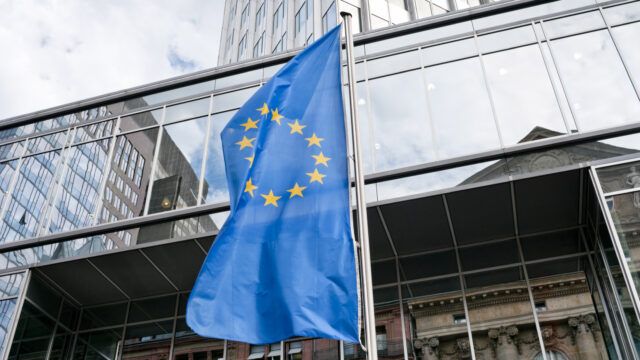The European Central Bank appears odds-on to leave interest rates on hold at its October meeting, in spite of rising energy prices. Weakening labour markets, more difficult PMI data and lacklustre household and corporate lending data are all conspiring to persuade policymakers to keep rates lower. The question is whether this might raise a smile for gloomy European equity markets.
The minutes from the last meeting of the ECB Monetary Policy Committee show the decision to raise rates was a close call. Ultimately, the hawks won. The concern appeared to be that markets might doubt the ECB’s commitment to controlling inflation if it decided to hold and there were concerns over rising food and energy prices. However, the minutes also showed that there were real fears on growth: “It was widely felt that, with hindsight, the June projections had been too optimistic about the strength of the economic recovery in 2023,” they said.
If anything, the picture has worsened since then. In its latest European outlook, Lazard says: “Relentlessly ratcheting up interest rates to subdue overheating economies is like steadily applying the brakes to a mile-long freight train—it takes a long time to slow the train down but eventually it grinds to a halt.
“The closely watched HCOB Eurozone Services PMI survey dipped into contractionary territory (a reading below 50) in August and remained there in September, even if it recorded a small uptick to 48.7. Meanwhile, the manufacturing PMI has bumped along below 45, a level last seen during the 2020 pandemic period, suggesting the European manufacturing sector is firmly in the doldrums.”
Anthony Willis, investment manager in the multi-manager team at Columbia Threadneedle, points out that futures markets are currently pricing in just 0.01% more in hikes in the eurozone, less than for the UK or US. “The market is basically saying ‘we’re done’.” He adds: “Growth has pretty much flatlined, so it won’t take much to tip the region into recession. Interest rates have gone up a lot. They only started hiking rates last summer, so a lot of that feed through is yet to come.”
In addition to the delayed effect of interest rates, the eurozone economy also has to cope with a flagging German economy, which has been hit hard by weakness in its manufacturing sector. Hourly productivity is falling across the region on the back of wage rises. Consumer sentiment indicators are turning downwards, and may fall further as pandemic savings become exhausted and higher interest rates feed through into household balance sheets.
The benefit for markets?
The problem is that while all this poor economic data makes interest rate rises less likely, it doesn’t do much to improve equity market sentiment either. No-one has been expecting a rate rise, so there is little marginal benefit from an ECB decision to hold.
That said, there may be other reasons to be more optimistic about European equities. Performance has been weak relative to other regions. The sector had a stronger start to 2023, but the average fund in the Europe ex UK sector is down 6.9% over the past three months, lagging the US, UK and emerging markets.
This has left valuations looking attractive. Tom Lemaigre, manager of the Janus Henderson European Select Opportunities fund, says: “Europe has a number of global champions that are really good at what they do. These include companies such as ASML – there would be no chips in a smartphone without ASML. Or Hermes, which has no equivalent in the luxury goods sector. There are also companies such as Luxottica (which owns Ray Ban) or Adidas. The difference is that in Europe, investors can buy these companies at a massive discount to the US.”
That discount gets bigger all the time. The MSCI Europe ex UK index stands on a forward price-to-earnings ratio of 12.6x, compared to 16.1x for the MSCI World or 22.5x for the Nasdaq. Lemaigre says: “What that means in practice is that investors either have to pray that interest rates go back to zero to justify buying at those levels or that earnings momentum for these companies stays good. In Europe, there is a real margin of safety.”
Nevertheless, there are no easy wins, which leads to the familiar narrative that Europe is a stockpicker’s market, with pockets of strong growth sitting alongside a lot of unexciting companies. This is borne out by the dispersion of returns for active managers – 20% between the top and bottom funds since the start of the year and 112% over three years.
Lemaigre points to a few key themes that are providing the lion’s share of Europe’s growth. Automation, for example, is being driven by companies’ need to improve productivity. Energy efficiency and electrification are helping companies protect themselves against volatile global energy markets. Europe proved particularly vulnerable to the energy shock created by the war in Ukraine. There is also a discernible near-shoring trend, as companies bring production closer to home to prevent supply shortages.
He points out that there are European companies benefiting from both the US and eurozone fiscal spending programmes, such as Dublin-based diversified building materials group CRH, or Swiss multinational Holcim Group. He says: “Europe is great at making things. We think the next decade will favour those who are good at making things.”
The ECB is vanishingly unlikely to raise rates at its meeting this week, but neither is it likely to galvanise the region’s lacklustre stockmarkets. There are still too many troubling economic factors. Nevertheless, that is no reason to avoid the region altogether. There are pockets of growth in companies benefiting from significant global trends, and valuations are cheap.
This story first appeared on our sister publication, Portfolio Adviser.

















